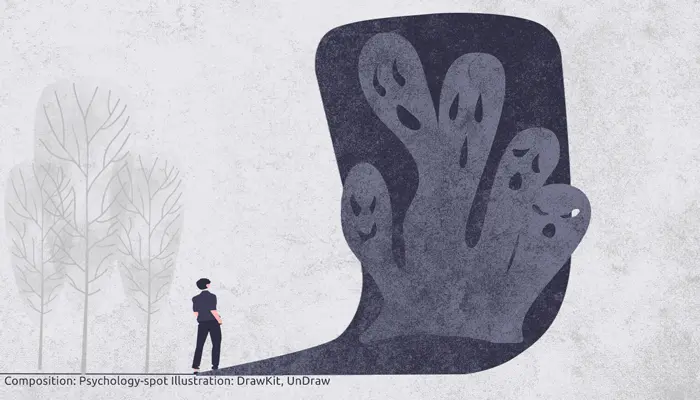
Listen to yourself!
Pay attention to your inner dialogue.
Look inside yourself.
These are some of the most common tips in Psychology. And there is no doubt that we must pay attention to ourselves, take note of our thoughts and understand our emotions. But everything has a limit. And when we exaggerate, we run the risk of becoming our main enemy.
The dangers of listening to yourself too much
Sometimes it is not the circumstances, but the narrative we construct that stresses and distresses us. When something happens to us, we don’t just react to that event, we also respond to the meaning we give to it, which depends largely on our thoughts.
And it’s very easy for those thoughts to derail.
In fact, a study conducted at the University of North Carolina found that we are not particularly good at controlling the direction of our minds. These psychologists asked a group of people to write down their thoughts throughout the day, randomly.
They discovered that 30% of the time they were not thinking about what they were doing. That is, their mind wandered, they were not fully present. In some people this tendency was even more pronounced: it occurred between 80 and 90% of the time.
Of course, many of these thoughts are harmless, but some have the potential to create a storm in a teacup, generating a completely unnecessary state of anxiety.
The main problem is that when we let our mind wander, it does not usually fantasize or make concrete plans for the future, but rather it becomes a worry-generating machine, as this research confirmed.
And we often identify so much with that catastrophic thinking that we assume it is real. As a result:
- We pay more attention to the dangers that our mind has created than to reality, which ends up creating a maladaptive gap that prevents us from solving the problem. In other words, looking inside distances us more and more from reality.
- We get stuck in a loop of worries that lead nowhere. We go around and around the situation, condemning ourselves to paralysis, while the problem continues to grow.
Our thoughts can become background noise that becomes increasingly intense, to the point of preventing us from hearing what is really happening and being able to draw up an action plan to solve it.
The 3 rules to avoid getting trapped in your thoughts
If you start believing everything you think, you will soon get trapped in the worry loop. The good news is that there is a better way to deal with those thoughts, to give them the importance they deserve, no more and no less.
Rule 1: You can’t control what you think, but you can control how you respond to those thoughts.
You must understand that there is an important difference between having thoughts and paying attention to those thoughts. Thoughts are like shooting stars, they arise spontaneously and you cannot control their appearance. But normally they last only a few seconds and fade away.
On the other hand, if you pay too much attention to thoughts that bring you nothing but anguish, you will be reinforcing and feeding them, so that they will multiply like a thousand-headed hydra. What can you do? Take note of their existence without dwelling on them too much. And to achieve this, you should not reject them but avoid taking them too seriously. You need to understand that they are just thoughts.
Rule 2: Thoughts are not reality
Every day we have thousands of thoughts, many of them seem true, especially when they are repeated over and over again. If you tell yourself “I’m not good enough” every day , you’ll probably end up believing it. On the other hand, negative thoughts and worries in particular generate very intense emotions that reinforce their veracity. If you think something terrible is going to happen and you experience fear and apprehension, you believe it is true. But is not!
When you pay too much attention to your thoughts and act as if they are true, you start to feel anxious and upset, which causes those ideas to arise more frequently. Then you mistakenly think they are important.
However, thinking something does not automatically turn that idea into a fact. It is more realistic to see thoughts for what they are: images and phrases generated by the mind that may be more or less attached to reality, but are not reality. Therefore, the next time you think about something, remember that these are simply ideas, reflections, images and reactions; but they are not reality.
Rule 3: You are not your thoughts
Just as thoughts are not reality, they do not define us as people. Of course, it’s easy to identify with their content since they’re ultimately in your mind, but you have to remember that it’s just a mental process, like memory.
In fact, did you know that our brain generates an average of 60,000 thoughts every day? It’s obvious that all those thoughts don’t define you. All kinds of ideas cross your mind, many of which are not meaningful or reflective of your true self.
The brain is a powerful machine for generating worries, fantasies and even contradictory ideas. But they are nothing more than fleeting mental events that do not necessarily reflect your identity. It is the decisions you make and the actions you take that ultimately reflect your “self.” Therefore, you should not give thoughts more importance than they deserve and, above all, you should not let them act as limiting beliefs.
When should you take your thoughts seriously?
Just because you shouldn’t believe everything you think doesn’t mean that thoughts are worthless and you shouldn’t take them seriously. You need to learn to distinguish the worries that need to be let go from those that need to be paid attention to.
How to achieve it? Simple, put your thoughts through the sieve of these questions:
- Is that thought in line with your values?
- Will it help you grow?
- Will it lead you to practical actions to improve something or avoid a problem?
If you have answered negatively to all of them, let that thought flow and disappear. The key is to get used to their existence and pay them due attention, but without taking them too seriously. In short, don’t believe everything you think: your mental health will thank you.
Reference:
Kane, M. J. et. Al. (2007) For whom the mind wanders, and when: an experience-sampling study of working memory and executive control in daily life. Psychol Sci; 18(7): 614-621.



